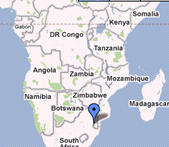Norwegian Scientists Depart for South Africa
14.06.2009 Bergen research scientists Harald Furnes and Nicola McLoughlin left Norway today to join South African colleagues currently drilling in the field. They plan to complete work sampling and logging c. 3.4 Billion year old Archean volcanic rocks of the Barberton mountain land and assist with the drilling operations.

Hovedinnhold
Why Drill? Robust studies of chemical and biological processes in ancient rocks require minimal contamination. At the earth's surface rocks are weathered and the lack of continuous outcrop hinders these studies. Only with drilling at depths in excess of tens of meters can we be sure that biological and chemical activities at the surface have not influenced the properties of the rock. Drilling allows us to access fresh unchanged rocks that still records process on the ancient earth many billions of years ago.
In addition to helping with the AEON-CGB Barberton Scientific Drilling Project the Norwegian scientists will be conducting further fieldwork on surface outcrops. Standard field gear they will be taking with them includes: topographic and geological maps plus aerial photos so they know exactly where they are in the field; geological hammers and chisels for collecting samples; tape measures and cameras so they can precisely locate where there samples come from and of course a notebook for recording information. They hope to return with many kilos of rocks sampled from the surface in addition to hundreds of meters of fresh, unweathered sub-surface rock obtained by the scientific drilling project this summer.
Photo: Harald Furnes studying pillow lavas (the large sub-spherical blocks in the cliff) in South Africa 2007.
Photo credit: Nicola McLoughlin
